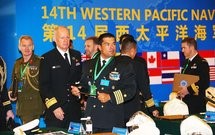 One of the hallmarks of the Western Pacific Naval Symposium (WPNS) held at Qingdao, China in April 2014 was the adoption of an agreement called the Code for Unplanned Encounters at Sea (CUES).
One of the hallmarks of the Western Pacific Naval Symposium (WPNS) held at Qingdao, China in April 2014 was the adoption of an agreement called the Code for Unplanned Encounters at Sea (CUES).
This agreement signed by the US, China and around two dozen Asia-Pacific nations (including India, Japan, South Korea, Philippines, Vietnam, Malaysia, Thailand and Australia amongst others) caters for improving communications when ships of the signatory nations meet in an unplanned event at sea and thereby reduce the possibility of any misunderstanding or collision that in turn could lead to increased friction. Admiral Wu Shengli, PLAN Chief, in his keynote address had stated that “For the sake of the extremely precious peace we enjoy at present, we need to … try to avoid extreme behaviours that may endanger regional security and stability.” Seen as a positive a step towards “establishing international standards in relation to the use of the sea,” as per the text of the agreement, the main loophole is that the agreement is not legally binding. This is an aspect that is clearly understandable as any legality attached to the agreement could have resulted it in either firstly, being rejected out right or secondly, following the path that the Code of Conduct for the South China Sea has meandered on since the first draft was rejected in 1999. In either case it would have been a non starter. The Chinese had earlier objected to CUES in the symposium held in 2012 and had objected to usage of the word ‘code’ as it made the agreement legally binding as well as the use of English in the document.
For CUES to become a reality there are some major decisions to be taken and milestones to be achieved by nations. These issues and concerns were aired during the meeting. The main issues that need to be resolved include the time frame for implementation, to what extent would nations adopt the code and intimation of any issue that is considered contentious or inimical to any nations interests.
Coming on the heels of the series of incidences involving ships from PLAN, the US, Japanese, Philippine, Vietnam and Indian navies, the agreement is considered noteworthy. However, as the euphoria of the agreement was settling, the Chinese stance on the CUES was made clear in an interview1 by the head of the Chinese Navy’s Maritime Security/Safety Policy Research Division. The main points were:
The agreement is a recommendation and not legally binding.
It is voluntary and does not apply in territorial waters
Applicability of usage, when and where would be dependent on bilateral talks.
The points are reminiscent of the stances the Chinese adopt in the South China Sea dispute; in the East China Sea and with respect to bilateralism from time to time. Adoption of the CUES in totality would weaken the Chinese stance in the South and East China Seas especially with respect to the islands and areas under dispute with Vietnam, the Philippines and Japan. In this context, Vice Admiral Xu Hongmeng, PLAN, had said that the agreement would have a positive impact on maritime conduct but would not make much of an impact in the disputed waters of the East and South China Seas2. Therefore, the Chinese are unlikely to agree to implementation of CUES in these areas except for perhaps in the context of selective extra regional navies with which they would establish a bilateral understanding.
Therefore, amongst the main players in the Asia Pacific region it appears that the main adherents to this agreement in its maximum applicability, as of now, would be PLAN and the US navy. This understanding is apparently based on the separate bilateral talks between the respective naval chiefs. In this regard Admiral Greenert the US Chief of Naval Operations had stated that it was not as formal or deliberate as CUES but was something that could be considered as a foundation.3
For CUES to be even marginally successful in the initial phase requires a follow up of actions by nations and improvements suggested to the code. In addition a lot would depend on how the Chinese adopt the code and implement it especially in the South and East China Seas.
By Special Arrangement with The Institute for Defence Studies and Analyses (www.idsa.in)